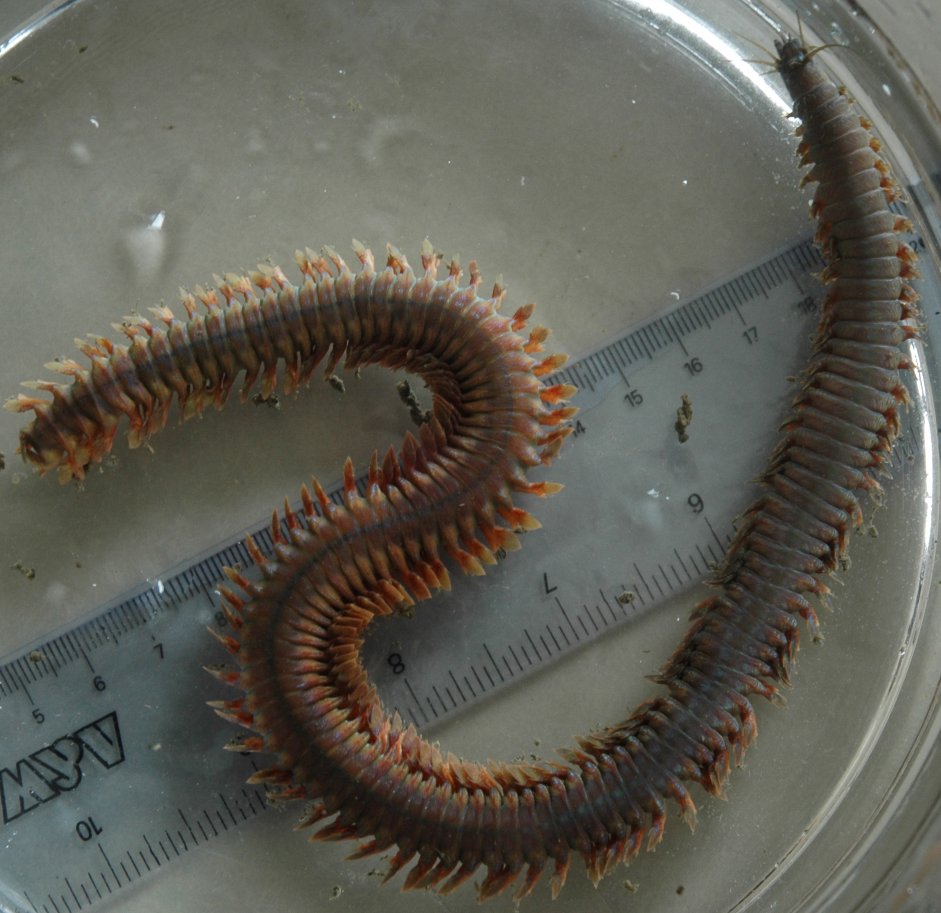Neanthes brandti (Malmgren, 1866)Common name(s): Pileworm, Giant pileworm |
|
| Synonyms: Alitta brandti, reis (Neanthes) brandti |  |
| Phylum Annelida
Class Polychaeta Order Phyllodocida Superfamily Nereidacea Family Nereididae |
|
| Neanthes brandti (tentatively
identified only by inspection) from
Padilla Bay, WA.
This could be N. vexillosa instead. |
|
| (Photo by: Dave Cowles, July 2005) | |
How to Distinguish from Similar Species: Nereis vexillosa is also frequently encountered. N. vexillosa differs from N. brandti in that the upper ligule of the notopodia in the posterior body are strap-shaped. It also does not grow as long as does N. brandti.
Note: This species was originally described by Malmgren as Alitta brandti, and current work may reclassify it back into that genus in the near future.
Geographical Range: BC, Canada to southern CA, off Siberia
Depth Range: Very low intertidal to subtidal
Habitat: Buried deep in mud or sand
Biology/Natural History: Predators include the Pacific staghorn sculpin Leptocottus armatus. This species swarms as epitokes during spawning, and swarms have been observed during spring and summer in CA. A close relative, Nereis virens, swarms about midnight in the dark of the moon during summer. During swarming, males can be distinguished by the white sperm showing through the body wall, while the posterior segments of females are red due to the eggs inside. In another relative, the Atlantic species Platynereis megalops, the females in a swarm bite off the posterior, sperm-bearing segments of the swarming males. After being swallowed and broken out of the male segments, the sperm pass through the wall of the female pharynx into her coelomic space, where they fertilize the eggs. The fertilized eggs are shed through ruptures in the body wall. The females do not shed their eggs until they are fertilized, and the eggs cannot be fertilized while free in the seawater.
Members of Family Nereididae seem to be very inefficient swimmers. While swimming as while crawling, they undulate their bodies back and forth in metachronous waves. While swimming these waves are of large amplitude and proceed from the back to the front of the animal (retrograde waves). These waves produce a current which tends to move the animal backward. At the same time, the frantic waving of the parapodia produces a current to drive the animal forward. The result is that the animal doesn't go much of anywhere and mostly thrashes around. The similar appearing Nephtys worms (Family Nephtyidae) use a much smaller metachronous body wave while swimming and can swim forward much more efficiently.
Nereids may be tubedwellers, mud borers, commensal, or
free-crawling
and free-swimming. Nereis brandti is the
largest polychaete
worm on our coast.
| Return to: | |||
| Main Page | Alphabetic Index | Systematic Index | Glossary |
References:
Dichotomous Keys:Kozloff 1987, 1996 [
as Nereis (Neanthes) brandti]
Smith and Carlton, 1975
General References:
MacGinitie
and MacGinitie, 1949
O'Clair
and O'Clair, 1998
Ricketts
et al., 1985
Sept,
1999
Scientific Articles:
Web sites:
General Notes and Observations: Locations, abundances, unusual behaviors:
July 27, 2005: I observed a large Nereis,
presumably Nereis
brandti or Nereis vexillosa, swimming
rapidly at the surface
in calm, undisturbed water about 30 m offshore in Sharpe's cove, in
water
about 5-7 m deep. The animal was at least 20 cm long and
appeared
to be longer because of a white stringlike substance that was attached
to the posterior end. Farther back the white "string" broke
up into
fragments that swirled away, and on closer inspection it turned out to
be a white milky stream of material that appeared to be exuding rapidly
from the posterior end of the animal. I believe the animal
was releasing
a large quantity of sperm into the water. The animal was
swimming
forward rapidly in nearly a straight line (heading approximately
offshore),
breaking the water's surface every 2-3 meters and swimming within 1/2
meter
of the surface the rest of the time. It was paddling
vigorously with
its parapodia and, though semicircular propulsive waves were passing
back
along its body, it was not writhing. First inspection
suggested that
the animal was complete rather than an epitoke. The time was
about
6 pm, which was halfway on the flood tide cycle (tide height +5 feet),
on the day of the half (waning) moon, and about 3 hours before
sunset.
A lone individual spreading sperm in the upper water column seems to be
pointless. I wonder if this species has mating swarms around
this
time, like the palolo worm, and whether this individual was just a
little
early or late for the main swarm? Perhaps I should examine
the water
at night and see if I can find more. --Dave Cowles
Authors and Editors of Page:
Dave Cowles (2005): Created original page